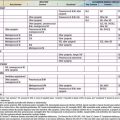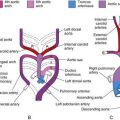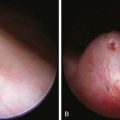Chapter 477 Disseminated Intravascular Coagulation
Etiology
Any life-threatening severe systemic disease associated with hypoxia, acidosis, tissue necrosis, shock, and/or endothelial damage may trigger DIC. A large number of conditions have been reported to be associated with DIC (Table 477-1). Although the clinical symptoms are more often hemorrhagic, the initiating event is usually excessive activation of clotting that consumes both the physiologic anticoagulants (protein C, protein S, and antithrombin III) and procoagulants, resulting in a deficiency of factor V, factor VIII, prothrombin, fibrinogen, and platelets. Commonly, the clinical result of this sequence of events is hemorrhage. The hemostatic dysregulation may also result in thromboses in the skin, kidneys, and other organs. Better understanding of the pathophysiology of hemostasis has lead to an appreciation of the critical interaction of the coagulation pathways with the innate immune system and inflammatory response that likely contributes to the widespread dysregulation present in DIC.
Table 477-1 CAUSES OF DISSEMINATED INTRAVASCULAR COAGULATION
INFECTIOUS
Meningococcemia (purpura fulminans)
Bacterial sepsis (staphylococcal, streptococcal, Escherichia coli, Salmonella)
Rickettsia (Rocky Mountain spotted fever)
Virus (cytomegalovirus, herpes simplex, hemorrhagic fevers)
Malaria
Fungus
TISSUE INJURY
Central nervous system trauma (massive head injury)
Multiple fractures with fat emboli
Crush injury
Profound shock or asphyxia
Hypothermia or hyperthermia
Massive burns
MALIGNANCY
Acute promyelocytic leukemia
Acute monoblastic or promyelocytic leukemia
Widespread malignancies (neuroblastoma)
VENOM OR TOXIN
Snake bites
Insect bites
MICROANGIOPATHIC DISORDERS
“Severe” thrombotic thrombocytopenic purpura or hemolytic-uremic syndrome
Giant hemangioma (Kasabach-Merritt syndrome)
GASTROINTESTINAL DISORDERS
Fulminant hepatitis
Severe inflammatory bowel disease
Pancreatitis
HEREDITARY THROMBOTIC DISORDERS
Antithrombin III deficiency
Homozygous protein C deficiency
NEWBORN
Maternal toxemia
Bacterial or viral sepsis (group B streptococcus, herpes simplex)
Abruptio placentae
Severe respiratory distress syndrome
Necrotizing enterocolitis
Erythroblastosis fetalis
Fetal demise of a twin
MISCELLLANEOUS
Severe acute graft rejection
Acute hemolytic transfusion reaction
Severe collagen-vascular disease
Kawasaki disease
Heparin-induced thrombosis
Infusion of “activated” prothrombin complex concentrates
Hyperpyrexia/encephalopathy, hemorrhagic shock syndrome
Placental abruption
Modified from Montgomery RR, Scott IP: Hemostasis: diseases of the fluid phase. In Nathan DG, Oski FA, editors: Hematology of infancy and childhood, vol 2, ed 4, Philadelphia, 1993, WB Saunders.
Treatment
The role of heparin in DIC is limited to patients who have vascular thrombosis in association with DIC or who require prophylaxis because they are at high risk for venous thromboembolism. Such individuals should be treated as outlined in Chapter 473.1, with careful attention to replacement therapy to maintain an adequate platelet count and thus limit bleeding complications.
Franchini M, Manzato F. Update on the treatment of disseminated intravascular coagulation. Hematology. 2004;9:81-85.
Levi M. Disseminated intravascular coagulation. Crit Care Med. 2007;35:2191-2195.
Levi M, Toh CH, Thachil J, et al. Guidelines for the diagnosis and management of disseminated intravascular coagulation. British Committee for Standards in Haematology. Br J Haematol. 2009;145:24-33.
Nadel S, Goldstein B, Williams MD, et al. Drotrecogin alfa (activated) in children with severe sepsis: a multicentre phase III randomised controlled trial. Lancet. 2007;369:836-843.
Nguyen TC, Carcillo JA. Bench-to-bedside review: thrombocytopenia-associated multiple organ failure—a newly appreciated syndrome in the critically ill. Crit Care. 2006;10:235.
Pipe SW, Goldenberg NA. Acquired hemostatic defects. In: Orkin SH, Nathan DG, Ginsberg D, et al, editors. Nathan and Oski’s hematology of infancy and childhood. ed 7. Philadelphia: Saunders Elsevier; 2009:1591-1622.
Sparrow A, Willis F. Management of septic shock in childhood. Emerg Med Australas. 2004;16:125-134.






